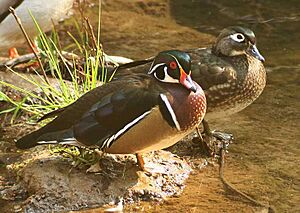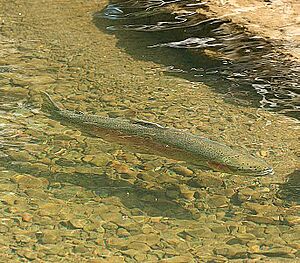Corte Madera Creek (Marin County) facts for kids
Quick facts for kids Corte Madera Creek |
|
|---|---|

Rowers on Corte Madera Creek
|
|
|
Location of the mouth of Corte Madera Creek in California
|
|
| Country | United States |
| State | California |
| Region | Marin County |
| Cities | Ross, Kentfield, Corte Madera |
| Physical characteristics | |
| River mouth | San Francisco Bay Corte Madera, California 0 ft (0 m) 37°56′30″N 122°30′08″W / 37.94167°N 122.50222°W |
| Basin features | |
| Tributaries |
|
Corte Madera Creek is a short stream in Marin County, California. It flows for about 4.5 miles (7.2 km) to the southeast. This creek is formed when two other creeks, San Anselmo Creek and Ross Creek, join together in a town called Ross.
The creek then flows into a tidal marsh near Kentfield. Finally, it connects to the San Francisco Bay close to Corte Madera.
History of Corte Madera Creek
Who Lived Here First?
For thousands of years, the Coast Miwok people lived in the area around Corte Madera Creek. They gathered plants like pinole and acorns for food. They also hunted animals and fished for salmon in the creeks. You can still find traces of the Miwok, like seven ancient mounds, in what is now the town of Ross.
How Did the Land Become Divided?
The Mexican government divided the land around Corte Madera Creek into two large areas. These were called "land grants."
- The Rancho Cañada de Herrera was a huge area of about 6,658 acres (27 km²). It included places like Fairfax and San Anselmo. This land was given to Domingo Sais in 1839. His family grew crops, raised sheep, horses, and cattle. They also fished for salmon in San Anselmo Creek.
- The Rancho Punta de Quentin was even bigger, about 8,877 acres (36 km²). It was given to Captain John B. R. Cooper in 1840. He was a sea captain from Boston. Captain Cooper cut down trees for wood. He also had permission to hunt southern sea otters, which were common near the mouth of Corte Madera Creek back then. Today, this rancho includes towns like San Anselmo, Ross, Kentfield, and Larkspur.
What Does the Name "Corte Madera" Mean?
The name "Corte Madera Creek" comes from the Spanish words corte de madera. This means "a place where wood is cut." It shows how important logging was in this area long ago.
Who Was James Ross?
James Ross was an immigrant from Tasmania. He became very wealthy by selling drinks to gold miners in San Francisco. In 1840, he bought a large part of the Rancho Punta de Quentin for $50,000. Ross continued to cut down trees for wood. He also started a regular boat service to San Francisco to transport the wood. His family built a large estate where the Marin Art and Garden Center is today.
Wildlife in Corte Madera Creek

Corte Madera Creek is special because it's one of the few streams flowing into San Francisco Bay that has a population of steelhead trout (Oncorhynchus mykiss). These fish are a type of rainbow trout that live in the ocean but return to freshwater to lay their eggs.
Where Do Fish Lay Eggs?
The best places for steelhead trout to lay their eggs are in Upper San Anselmo Creek, Ross Creek, and Sleepy Hollow Creek. Unfortunately, Fairfax Creek has a barrier that stops fish from swimming upstream. Some people say that Larkspur Creek used to have steelhead a long time ago. You might still see a steelhead in Tamalpais Creek sometimes. Chinook salmon (Oncorhynchus tshawytscha) also use this creek system.
What Other Fish Live Here?
Besides salmon and trout, many other fish species live in Corte Madera Creek. These include:
- Three-spined stickleback (Gasterosteus aculeatus)
- California roach (Lavinia symmetricus)
- Several types of sculpin (Cottus spp.)
- Sacramento sucker (Catostomus occidentalis occidentalis)
What Other Animals Live Here?
The creek is home to many protected animals and plants. Besides steelhead trout, you might find:
- At least 17 different types of plants
- Northern spotted owls (Strix occidentalis caurina)
- San Pablo song sparrows (Melospiza melodia samuelis)
- Ridgway's rail (Rallus obsoletus) and black (Laterallus jamaicensis) rails
- The salt marsh harvest mouse (Reithrodontomys raviventris)
The Corte Madera Marsh Ecological Reserve is a large area of about 1,000 acres (4 km²). It's recognized as an Important Bird Area by the Audubon Society, meaning it's a great place for birds. Just south of the marsh, in a channel called San Clement Creek, harbor seals (Phoca vitulina) often rest on the land.
The Corte Madera Watershed
What is a Watershed?
A watershed is an area of land where all the water drains into a single river, lake, or ocean. The Corte Madera Watershed is also known as the Ross Valley Watershed. It covers about 28 square miles (73 km²) in the southeastern part of Marin County.
Where Does the Water Come From?
The land in this watershed ranges from sea level up to 2,571 feet (784 m) at the East Peak of Mount Tamalpais. The watershed includes several towns like Larkspur, Corte Madera, Kentfield, Ross, San Anselmo, and Fairfax. It also includes many creeks such as Corte Madera, Ross, San Anselmo, Tamalpais, Sleepy Hollow, Fairfax, and Cascade creeks, as well as Phoenix Lake.
How Do the Creeks Flow?
The watershed has about 44 miles (71 km) of stream channels. Ross Creek drains the northern side of Mount Tamalpais. San Anselmo Creek and its smaller streams drain the northwestern part of the watershed. These two main channels join to form Corte Madera Creek. This creek then flows through a concrete-lined channel for over a mile. It passes where Larkspur and Tamalpais Creeks join it, and then flows into the salt marsh at its mouth.



